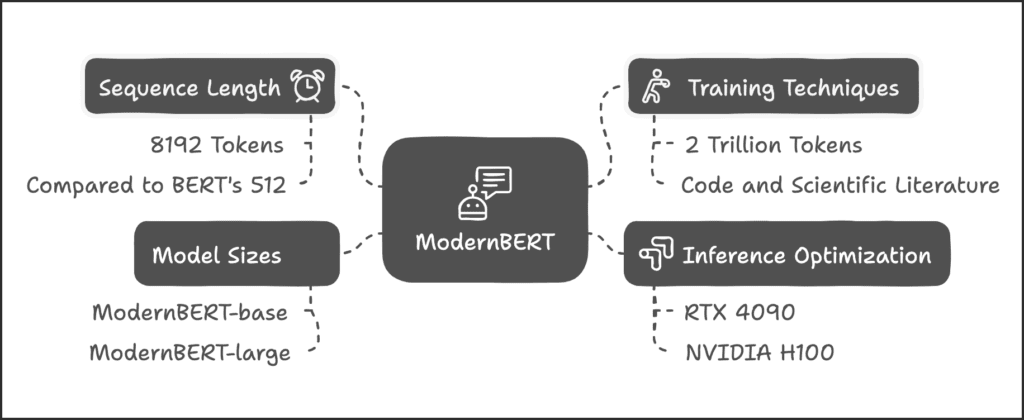Mastering ModernBERT: The Evolution of Encoder Models

Explore more from ADaSci
Encoder-based models like BERT have been the backbone of many natural language processing (NLP) applications. However, as new challenges in retrieval, classification, and efficiency emerge, modernized versions of these models are needed to meet growing demands. Enter ModernBERT, a state-of-the-art bidirectional encoder that combines modern architectural advancements with efficiency optimizations. In this article, we will be exploring the features, implementation, and use cases of ModernBERT.
Table of Content
- What is ModernBERT?
- Key Features of ModernBERT
- Hands-On Implementation
- Technical Insights
- Use Cases and Applications
What is ModernBERT?
ModernBERT is a modernized version of BERT, designed to improve both downstream performance and efficiency. Unlike its predecessor, it supports:
- Longer sequences: A native sequence length of 8192 tokens compared to BERT’s 512.
- Modern training techniques: Trained on 2 trillion tokens with a data mixture that includes code and scientific literature.
- Optimized inference: Designed for hardware efficiency on common GPUs, including RTX 4090 and NVIDIA H100.
ModernBERT is available in two sizes:
- ModernBERT-base (149M parameters)
- ModernBERT-large (395M parameters)
These models outperform prior encoders in a range of benchmarks while maintaining computational efficiency.

Key Features of ModernBERT
Advanced Positional Embeddings
ModernBERT uses rotary positional embeddings (RoPE), which outperform absolute embeddings, particularly in handling long-context scenarios.
Improved Architectures
Key architectural upgrades include:
- GeGLU Activation: A gated activation function that improves training stability and model performance.
- Local and Global Attention: Alternating attention mechanisms balance efficiency with performance.
- Pre-Normalization Blocks: Ensure stable training across long contexts.
Unpadding for Efficiency
ModernBERT avoids inefficiencies in padded sequences by utilizing unpadding techniques, significantly speeding up training and inference.
Hardware-Aware Design
ModernBERT’s architecture maximizes GPU utilization, delivering faster inference speeds and supporting larger batch sizes.
Hands-On Implementation
Step 1: Install Necessary Libraries
Install the Hugging Face `transformers` library and Flash Attention for optimized inference.
!pip install git+https://github.com/huggingface/transformers.git
!pip install flash-attnStep 2: Import Libraries
Import essential libraries such as `torch`, `transformers`, and `pprint` for loading the model and running inference.
import torch
from transformers import AutoTokenizer, AutoModelForMaskedLM, pipeline
from pprint import pprintStep 3: Load the ModernBERT Model and Tokenizer
Specify the ModernBERT model ID and load both the tokenizer and model using the `transformers` library.
model_id = "answerdotai/ModernBERT-base"
tokenizer = AutoTokenizer.from_pretrained(model_id)
model = AutoModelForMaskedLM.from_pretrained(model_id, torch_dtype=torch.bfloat16)Step 4: Check GPU Availability
Determine if a GPU is available and load the model onto the appropriate device for faster processing.
device = "cuda" if torch.cuda.is_available() else "cpu"
model.to(device)Step 5: Set Up the Fill-Mask Pipeline
Initialize a pipeline for masked language modeling using the ModernBERT model and tokenizer.
pipe = pipeline(
"fill-mask",
model=model,
tokenizer=tokenizer,
device=0 if device == "cuda" else -1
)Step 6: Provide Input Text
Define a text input containing a [MASK] token for the model to predict.
input_text = "He walked to the [MASK]."Step 7: Perform Inference
Use the pipeline to predict the token that should replace the [MASK] in the input text.
results = pipe(input_text)Step 8: Display Results
Output the model’s predictions for the masked token in a readable format.
pprint(results)Output:-
Technical Insights
Training Efficiency
ModernBERT employs:
- Sequence Packing: Reduces minibatch variance and improves training throughput.
- StableAdamW Optimizer: Enhances stability during training.
Inference Speed
ModernBERT processes tokens nearly two times faster than previous models, with optimized memory usage enabling larger batch sizes.
Downstream Performance
ModernBERT sets new benchmarks in:
- General Language Understanding (GLUE)
- Dense Passage Retrieval (DPR)
- CodeSearchNet for code retrieval
Use Cases and Applications
Retrieval-Augmented Generation (RAG)
ModernBERT excels in information retrieval tasks, making it an ideal component for RAG pipelines. It efficiently retrieves relevant documents, improving the performance of large language models in downstream tasks.
Long-Context Text Retrieval
With a sequence length of 8192 tokens, ModernBERT is well-suited for long-document retrieval applications, including legal and scientific research.
Code Understanding
Pretrained on code datasets, ModernBERT supports code search and retrieval, aiding in programming and development workflows.
Final Words
ModernBERT redefines what encoder-based models can achieve. With its hardware-aware design, long-context support, and state-of-the-art performance, it is poised to become a cornerstone for NLP and IR tasks. Whether you’re a researcher, developer, or AI enthusiast, ModernBERT offers the tools to tackle complex challenges efficiently and effectively.






